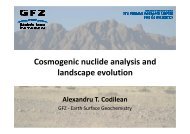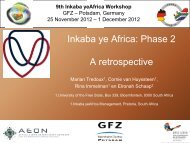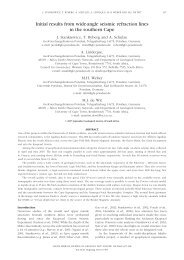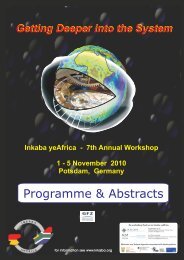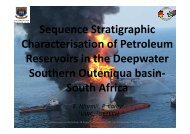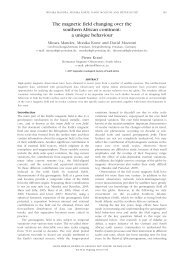South Africa - Inkaba.org
South Africa - Inkaba.org
South Africa - Inkaba.org
Create successful ePaper yourself
Turn your PDF publications into a flip-book with our unique Google optimized e-Paper software.
The application of facies analysis on sedimentary evolution<br />
and changes in sea-level on the Kookfontein and Waterford<br />
Formation in the Permian Ecca Group, Tanqua, Karoo Basin<br />
R. Arenz¹, D.Mikeš²<br />
1. Stellenbosch University, <strong>South</strong> <strong>Africa</strong>, renitia@gmail.com<br />
2. Stellenbosch University, <strong>South</strong> <strong>Africa</strong>, mikes@sun.ac.za<br />
ABSTRACT<br />
Facies are considered as deposited by a unique set of physical processes which can be interpreted from lithologies,<br />
textures, primary sedimentary structures, fossil content and stratigraphic position. In many cases the observed<br />
sedimentary structures alone are not sufficient to unequivocally assert the mode of deposition and in places comparison<br />
with models described in literature may even be misleading.<br />
The aim if this study was thus to; Analyse the sequence in which the facies occur, providing information about the<br />
facies itself; the relationship between depositional environments and stratigraphic sequences developed through time as<br />
a result of transgressions and regressions. Evaluating controls on sedimentary facies architecture, incorporating facies<br />
analysis and interpretation. Evaluating the use of facies architecture to infer sea-level change. Using facies architecture<br />
to determine depositional setting.<br />
During a month long period of field work Phase 1 in the Tanqua and Laingsburg depocenters, an outcrop field study<br />
was carried out to facilitate compilation of detailed sedimentary logging, and vertical profiles accompanied by outcrop<br />
gamma log data facilitating easy comparison with subsurface data sets for correlation of the Waterford and Kookfontein<br />
formations’ lithologies and radioactive decay properties. Detailed stratigraphic mapping was carried out using a<br />
portable multi-channel scintillation spectrometer, SGR data collected is used as a correlation tool. The spectral gamma<br />
ray (SGR) tool measured the total gamma ray (GR) and the individual contribution from the three major radioactive<br />
sources, namely 40K, 238U and 232Th, in a given time. Data collected will be presented in seconds (sec). The<br />
sedimentary successions were then logged by measuring the gamma radiation at an average vertical spacing of 50 - 75<br />
cm over a selected time interval, namely 180 seconds for the argillaceous units and 240 seconds for sandstone.<br />
Sedimentological and gamma ray profiles were measured from the basin-floor deposits to the base of the deltaic<br />
successions in the Tanqua sub basin. The locations for these profiles were chosen on best outcrop positions for regional<br />
correlation by using arial photographs geological and topographic maps. Samples were collected from fresh outcrop<br />
surfaces where possible, concentrating mudstone sampling between fans/units, and sandstone samples at the start and<br />
end of major depositional facies. Samples were taken at vertical intervals for the purpose of constraining regional<br />
correlations.<br />
Through a collaborative study at Stellenbosch University sedimentology research group, interpretation of facies, based<br />
on spatial relations and internal characteristics (lithology and sedimentary structures) using information from<br />
stratigraphic units and facies subdivision will be used to construct a new facies model for the Kookfontein and<br />
Waterford Formations of the upper Ecca shelf to slope succession in the Tanqua depocentre .<br />
KEYWORDS: Facies architecture ;sea- level change; Kookfontein Formation; Waterford Formation; Tanqua sub-<br />
basin.<br />
2



